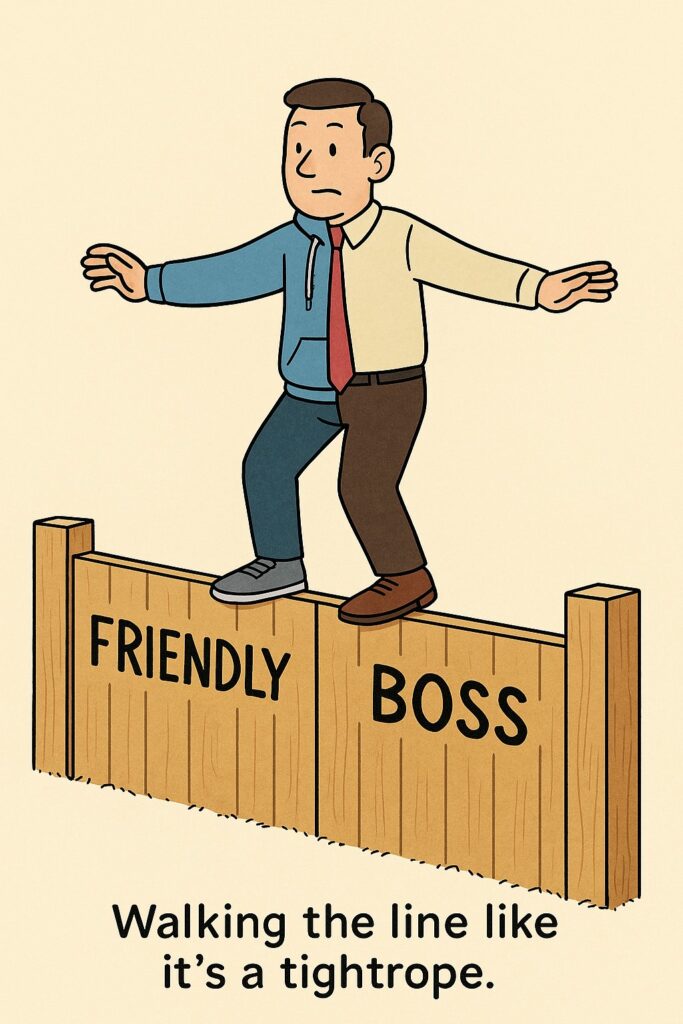This is one of those questions that everyone seems to have a different answer for.

Some leaders keep it all business, all the time—no personal connection, no warmth, no gray area. Others go the opposite direction. They want to be friends, hang out, be the “cool boss.”
But I think there’s a better path somewhere in the middle.
Years ago, I was building an app for hospital leadership and interviewed several executives who’d seen a lot of success (whether they were great leaders is another debate). I asked each of them a few core questions—especially about how they approached trust and relationships with their teams.
The answer I kept hearing in different variations was this:
“You’re the boss. You always have to be the boss. But… you also have to have a relationship.”
You’re going to be working with these people 40, 50, maybe even 60 hours a week. Year after year. If there’s zero relationship, you’re both going to be miserable. You need to be able to enjoy being around your team—have conversations, laugh, understand who they are as people.
But you also need boundaries.
When I first got put in charge of people back in my early twenties, I made a bunch of mistakes. The biggest one? Trying to be a hangout buddy with my team. Going to happy hour. Getting too casual. I thought that would help build connection and loyalty—but all it did was blur the lines of authority and make everything harder.
If you want to lead, that’s a trade-off you have to make. You don’t get to be “just one of the crew” anymore. You’re the boss.
One friend of mine had a style that leaned very friendly—he liked being close with his team, genuinely enjoyed the camaraderie. But when a performance issue came up with one of those friends, he handled it differently. He didn’t say, “You’re in trouble.” He said, “I’m going to be honest with you. I care about you. And I know you’re better than this.”
That conversation worked because there was a relationship.
But it’s not all upside. The hardest part of being friendly with your team is when things go south—when you have to reprimand someone, deliver bad news, or in the worst case, let someone go. That stuff is always hard, but it’s even harder when there’s a personal connection.
And here’s the part we all need to keep in mind:
People don’t quit companies. People quit managers.
Sure, sometimes it’s about compensation, or a big external opportunity. But most of the time when someone mentally checks out, quietly quits, or sends in their two weeks—it’s because of the local environment. They don’t feel supported. They don’t feel heard. And that’s on us.
One other thing worth keeping in mind: when you sign up to be a manager, whether you like it or not, you are literally being paid to have the company’s best interests in mind.
That doesn’t mean you stop caring about your team—but it does mean you have to make hard calls through a different lens.
When something comes up, I take a step back and ask:
What am I getting paid to do?
I’m getting paid to manage these teams and deliver the best possible outcomes for the company. That framing helps me sort through tough decisions.
Do I raise expectations? Would that be best for the company?
Do I hold someone accountable? Will it help the team as a whole?
That filter helps bring clarity—and keeps the role from becoming just a popularity contest or a series of emotional reactions.
So here’s my take:
- Yes, build a relationship.
- Yes, be human and approachable.
- But always leave a little space.
You are the manager. That doesn’t mean you need to act like a robot. But it does mean you need to hold the line when things get tough—and you need to lead, not just hang out.
A healthy relationship makes work better. It makes conversations easier. But it only works if it’s built on mutual respect and trust—not just friendship.
What’s your approach?
Have you ever gotten too close to your team—or not close enough?
💡Liked this post?
Get real-world solutions like this in your inbox—join the newsletter.